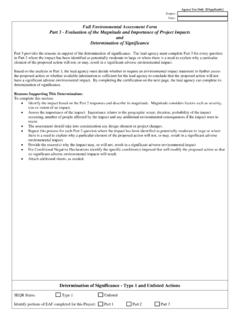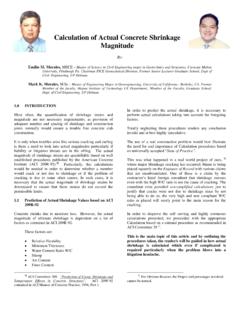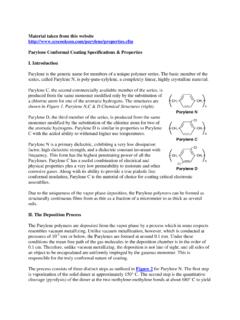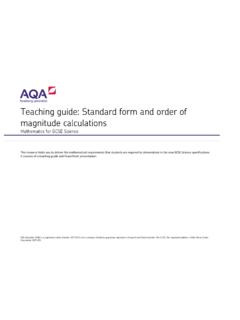Transcription of Sources of vibration magnitude data
1 Sources of vibration magnitude data Selecting suitable vibration magnitude data 1 You should be cautious when identifying vibration magnitude data from which to estimate employee vibration exposures. You need to be careful to select a value that is representative of your work activities and will not produce an underestimate of vibration exposures. vibration magnitudes associated with machines have changed in recent years (up in some cases, down in others) and you should as far as possible try to obtain up-to-date information. vibration data is collected for many purposes and is not always suitable for use in estimating daily vibration exposures.
2 vibration data that may not represent the work you are doing includes data measured during non-working conditions such as idling; data used as part of maintenance checks; and data for comparing vibration emissions collected under tightly controlled non-working conditions. 2 You can increase your confidence in the quality or relevance of available vibration magnitude information by comparing data from at least two Sources and seeking an explanation of any inconsistent vibration magnitudes. data based on several models of a machine type may be more robust than data for an individual machine model.
3 However, if data from several Sources shows that the vibration of a particular model of machine is lower than is generally expected for machines of the same type, using that lower vibration model may reduce vibration exposures. 3 Many organisations hold information on measured vibration magnitudes, including manufacturers of work equipment, employers, trade associations, government bodies and consultants. vibration data is available through technical and scientific publications and from on-line databases. You may be able to find relevant vibration information from others who have experience with the work processes and machines you use.
4 You are likely to be able to find relevant vibration information for at least your initial assessment of vibration exposures without the need to make measurements yourself. vibration magnitudes measured for HSE 4 HSE s guidance book Hand-arm vibration (L140) contains a Table of examples of vibration magnitudes that have been measured by HSE on tools in real work situations. The Table 1 in this document is an updated version of the Table in L140. 5 Table 1 contains a summary of vibration magnitudes of some common machines measured for HSE. The 'Tool type', 'Tool characteristic, inserted tool, size, process' and 'Notes' should be used to check that there is a close match between your machine and the machine for which vibration data is provided.
5 Making an initial estimate of vibration exposure 6 You can use the 'recommended initial value' vibration magnitudes in Table 1 in combination with your observations of durations of exposure (trigger times) to make an initial estimate of daily vibration exposures. In many cases, this will be sufficient for you to determine your duties under the regulations and to review your control measures and revise them as necessary. The 'recommended initial value' is a vibration magnitude that is in the upper part of the range of vibration emissions during normal use of many models of the machine type.
6 The actual vibration exposures may be lower than your estimates. However, vibration magnitudes can be higher than the 'recommended initial value' and you should make allowance for this. For example, if your estimated exposures are approaching the EAV you should assume that the EAV is likely to be exceeded. Reducing vibration exposure by choosing lower vibration models of machine 7 For many machines, there is scope for reducing vibration exposures by avoiding high- vibration models of a machine type. There will always be some range in the vibration magnitudes due to differences in the work activity, the operators' techniques, and the condition of the tool etc.
7 The greater the difference between the 'Range-lower' and 'Range-upper' values in Table 1, the higher the likelihood that there are clear differences between the vibration hazard of competing models of a machine type. The wider the range, the more likely it is that there is scope for you to reduce vibration exposure by using vibration magnitude to choose between models of a tool type, for example, using vibration data for real use from reliable Sources . Selection on the basis of vibration should be made from a shortlist of tools that have already been shown to be well suited to the work.
8 Table 1 A summary of vibration magnitudes of some common machines Industry Tool type Tool characteristic, inserted tool, size, process Notes Range-lower (10%ile) (m/s ) Range-upper (90%ile) (m/s ) Recommended initial value (75%ile) (m/s ) General Drills Standard drill bit vibration values can vary across the many sub-categories (eg small to large) and different materials being worked. Larger drills tend to give higher vibration values. Maintaining sharp drill bits is important 2 5 5 General Drills Hole saw 4 12 10 General Drills Core 78 107 mm Can give very high vibrations if operators push too hard.
9 Maintaining sharp drill bits is important 6 8 8 General Drills Impact 5 and 8 mm masonry bit Can give very high vibrations if operators push too hard. Maintaining sharp drill bits is important 7 13 11 General Grinders Angle 100 180 mm vibration values will depend on force being applied and different materials being worked. Selecting the right grade of abrasive and applying the right forces can help to minimise exposures 3 10 7 General Grinders Angle 125 and 100 mm Flapper discs 2 5 4 General Grinders Angle 220 300 mm vibration values can vary across the many sub-categories and different materials being worked.
10 Applying too much force can produce lobing of the discs and significantly increase vibration levels 4 11 9 General Grinders Die 5 10 8 General Grinders Straight Correct selection of the abrasive will ensure that workers do not apply excessive force and keep vibration magnitudes to a minimum 4 9 8 General Nail guns Measured vibration levels are dependent upon rates of use. It can be difficult to assess exposure times correctly 3 13 9 Industry Tool type Tool characteristic, inserted tool, size, process Notes Range-lower (10%ile) (m/s ) Range-upper (90%ile) (m/s ) Recommended initial value (75%ile) (m/s ) General Needle scalers Non- vibration reduced 12 26 19 General Needle scalers vibration reduced 3 8 7 General Nibblers 7 12 12 General Reciprocating saws Operator training and work organisation is important.


















